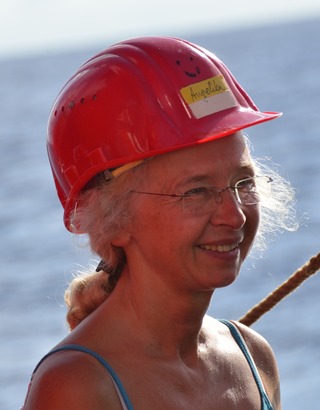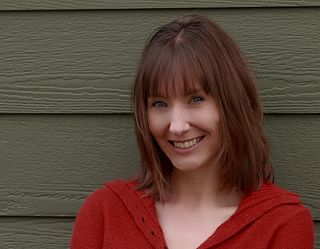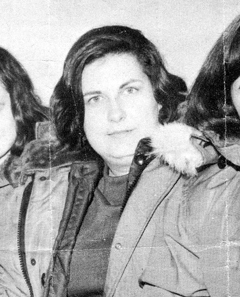Related Research Articles

A polynya is an area of open water surrounded by sea ice. It is now used as a geographical term for an area of unfrozen seawater within otherwise contiguous pack ice or fast ice. It is a loanword from the Russian полынья, which refers to a natural ice hole and was adopted in the 19th century by polar explorers to describe navigable portions of the sea.
Ian Grote Stirling is a research scientist emeritus with Environment and Climate Change Canada and an adjunct professor in the University of Alberta Department of Biological Sciences. His research has focused mostly on Arctic and Antarctic zoology and ecology, and he is one of the world's top authorities on polar bears. Stirling has written five books and more than 150 articles published in peer-reviewed scientific journals. He has written and spoken extensively about the danger posed to polar bears by global warming.

Maria Vasilyevna Klenova was a Russian and Soviet marine geologist and one of the founders of Russian marine science and contributor to the first Soviet Antarctic atlas.
Deneb Karentz is full-time faculty, professor, and chair of the Biology Department at University of San Francisco. Her research focuses on the ultraviolet photobiology of marine organisms and understanding their strategies for protection from UV exposure, particularly in relation to the ecological implications of Antarctic ozone depletion.

In-Young Ahn is a South Korean scientist. She is known for being the first South Korean woman to visit Antarctica and the first Asian woman to become an Antarctic station leader. She is a benthic ecologist and is currently working as a principal research scientist for the Korea Polar Research Institute.

Terry Jean Wilson is an international leader in the study of present-day tectonics in Antarctica. She has led large, international efforts, such as Polar Earth Observing Network (POLENET), to investigate the interactions between the Earth's crust and the cryosphere in Antarctica.

Angelika Brandt is the world leader in Antarctic deep-sea biodiversity and has developed, organised and led several oceanographic expeditions to Antarctica, notably the series of ANDEEP cruises, which have contributed significantly to Antarctica and deep-sea biology. Brandt was the senior scientist of ANDEEP which was devoted entirely to benthic research in the Antarctic abyss.
Carlota Escutia Dotti is a Spanish geologist, best known for her work on the geologic evolution of Antarctica and the global role of the Antarctic ice cap. Escutia is based at the Instituto Andaluz de Ciencias de la Tierra, Universidad de Granada and the High Council for Scientific Research (CSIC).

Amy Leventer is an American Antarctic researcher specialising in micropaleontology, with specific research interests in marine geology, marine biology, and climate change. Leventer has made over a dozen journeys to the Antarctic, which began at the age of 24 and led to the pursuit of her PhD.
Florica Topârceanu is an Antarctic researcher, best known for her work was on Antarctic aquatic viruses and the development of the Antarctic scientific community in Romania. She was the first Romanian woman biologist to study life in Antarctica and the first Romanian woman expert to the Antarctic Treaty.

Anna Wåhlin is a Swedish researcher on the Antarctic and the polar seas. She is a professor of physical oceanography at the University of Gothenburg and co-chair of the Southern Ocean Observing System.

Irene R. Schloss is an Antarctic researcher, best known for her work on plankton biology. She is a researcher at the Argentine Antarctic Institute and was a correspondent researcher of the National Scientific and Technical Research Council of Argentina until July 2017. She became an independent researcher since August 2017 and an associate professor at the University of Quebec.

Cristina Takacs-Vesbach is an American microbial ecologist conducting research on the productivity, diversity, and function of microbial communities living at the two extremes of temperature found on Earth-Antarctica's McMurdo Dry Valleys and Yellowstone National Park's thermal springs.

Katrin Linse is a German marine biologist, best known for her work on discovering new Antarctic and deep sea species.

Trista Vick-Majors is an American Assistant Professor in Biological Sciences at Michigan Tech. She is an Antarctic biogeochemist and microbial ecologist, best known for her work showing that microorganisms are present under the Antarctic ice sheet.

Siti Aisah Binti Hj Alias is a Malaysian marine polar researcher and lecturer. As of August 2016, she is Associate Professor and Director of the National Antarctic Research Centre (NARC) in the Malaysian Antarctic Research Programme (MARP), at the University of Malaya. Her work focuses on the physiology of marine and polar microbes and fungi.

Catherine Ritz is a French Antarctic researcher, best known for her work on ice sheets and their impact on sea level rise.

Lois M. Jones was an American geochemist who led the first all-woman science team to Antarctica in 1969. They were also the first women to reach the South Pole. Jones was well regarded for her contribution to geological research in the McMurdo Dry Valleys, one of the few ice-free areas of Antarctica, and published many papers and abstracts.

Kim Crosbie is a former Executive Director of the International Association of Antarctica Tour Operators (IAATO) and has been working in the polar regions since 1991.

Louise Tolle Huffman is an American teacher with over 30 years of teaching experience with many years focused on polar science and climate studies, and has written educational outreach books and articles on Antarctica. She is the Director of Education and Outreach for the US Ice Drilling Program Office (IDPO), responsible for outreach efforts highlighting IDPO scientists and their research results.
References
- 1 2 "5 things diver Kathleen Conlan can't leave home without | Toronto Star". thestar.com. 18 December 2015. Retrieved 2016-06-18.
- 1 2 3 4 5 "Kathleen E. Conlan—Professional Profile". nature.ca. Canadian Museum of Nature. Archived from the original on 2019-01-15. Retrieved 2016-06-18.
- ↑ "The Benthic Lab in Antarctica | MLML 50th Anniversary". anniversary.mlml.calstate.edu. Retrieved 2016-06-18.
- ↑ Hildebrand, John (2005-01-01). A Northern Front: New and Selected Essays. Minnesota Historical Society. ISBN 9780873515283.
- ↑ Conlan, Kathleen E.; Kim, Stacy L.; Lenihan, Hunter S.; Oliver, John S. (2004-07-01). "Benthic changes during 10 years of organic enrichment by McMurdo Station, Antarctica". Marine Pollution Bulletin. 49 (1–2): 43–60. Bibcode:2004MarPB..49...43C. doi:10.1016/j.marpolbul.2004.01.007. PMID 15234873.
- 1 2 3 "science.ca : Kathy Conlan". www.science.ca. Retrieved 2016-06-18.
- 1 2 "science.ca : Kathy Conlan". www.science.ca. Retrieved 2019-03-07.
- ↑ "Nunatsiaq News". www.nunatsiaqonline.ca. Archived from the original on 2016-10-12. Retrieved 2016-06-18.
- ↑ Sopinka, Natalie (2014-11-14). "Upwelling". Phish Doc. Archived from the original on 2016-06-23. Retrieved 2016-06-18.
- ↑ Paquette, Nicole. "Educational Videos from the Canadian Museum of Nature". nature.ca. Archived from the original on 2016-09-15. Retrieved 2016-06-18.
- 1 2 "Canadian Committee on Antarctic Research (CCAR) | Canadian Polar Commission". www.polarcom.gc.ca. Archived from the original on 2016-08-08. Retrieved 2016-06-18.
- ↑ "Membership". www.scar.org. Retrieved 2016-06-18.
- 1 2 "Tinker-Muse Prize for Science and Policy in Antarctica". www.museprize.org. Archived from the original on 2016-08-05. Retrieved 2016-06-18.
- ↑ Conlan, Kathleen (2015-07-29). "An Exceptional Antarctic Scientist". Canadian Museum of Nature - Blog. Retrieved 2016-06-18.
- ↑ Woolston, Chris (2015-12-10). "Marine biology: Charting sea life". Nature. 528 (7581): 295–297. doi: 10.1038/nj7581-295a . PMID 26677466.
- ↑ Canadian Museum of Nature (2010-07-02), Antarctic Pollution , retrieved 2016-06-18
- ↑ "Google Search" . Retrieved 2016-06-18.
- ↑ "Client Validation". www.vanaqua.org. Retrieved 2016-06-18.
- ↑ "Arctic Voices | International Sales | Science North". sciencenorth.ca. Archived from the original on 2016-06-28. Retrieved 2016-06-18.
- ↑ "Extraordinary Arctic | Canadian Museum of Nature". nature.ca. Retrieved 2016-06-18.
- ↑ "Travelling Exhibition: Canada's Waterscapes | Canadian Museum of Nature". nature.ca. Retrieved 2016-06-18.
- ↑ "Underwater Field Guide to Ross Island & McMurdo Sound, Antarctica". www.peterbrueggeman.com. Retrieved 2016-06-18.
- ↑ "About Us - Students on Ice". Students on Ice. Archived from the original on 2016-05-19. Retrieved 2016-06-18.
- ↑ "Kathleen Conlan - Canada's Greatest Explorers - Canadian Geographic". Canadian Geographic. Retrieved 2016-06-18.[ permanent dead link ]
- ↑ "Canada's greatest modern women explorers". Canadian Geographic. Archived from the original on 2016-03-19. Retrieved 2016-06-18.
- ↑ Conlan, Kathy; Nature, Canadian Museum of (2004-08-01). Under the Ice: A Marine Biologist at Work. Toronto: Kids Can Press. ISBN 9781553370604.
- ↑ "2002 Science in Society Book Award Recipient: Kathy Conlan - Canadian Children's Book Centre". Canadian Children's Book Centre. Retrieved 2016-06-18.
- ↑ "Under the Ice". Goodreads. Retrieved 2016-06-18.
- ↑ "About Kathy Conlan". KATHLEEN e. CONLAN. Retrieved 2016-06-18.
- ↑ "Canadian Scientist". Gurneet Saini's E-portfolio. Retrieved 2016-06-18.